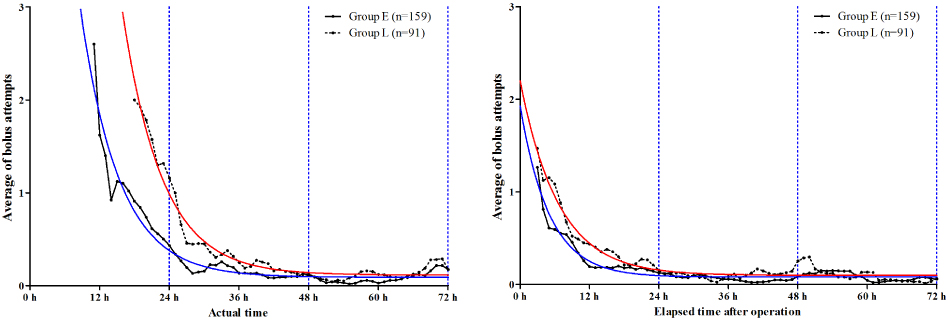J Dent Anesth Pain Med.
2015 Sep;15(3):141-146.
Circadian variation of IV PCA use in patients after orthognathic surgery: a retrospective comparative study
- Affiliations
-
- 1Department of Dental Anesthesiology, Seoul National University Dental Hospital, Seoul, Korea.
- 2Department of Dental Anesthesiology, Dental Research Institute, School of Dentistry, Seoul National University, Seoul, Korea. stone90@snu.ac.kr
Abstract
- BACKGROUND
An understanding of the features of postoperative pain is essential for optimal analgesic dosing strategies. Using a visual analogue scale (VAS) score and patient controlled analgesia (PCA) infusion pattern analysis, an anesthesiologist can estimate when and how severely patients suffer from pain. Several reports have been published about circadian changes in the pain threshold. Postoperative pain was analyzed retrospectively in 250 patients who underwent orthognathic surgery.
METHODS
A total of 250 patients were allocated into two groups according to the time of recovery from anesthesia. Patients in the early group (group E) recovered from anesthesia before 06:00 p.m. Patients in the late group (group L) recovered from anesthesia after 06:00 p.m. All patients received intravenous patient controlled analgesia (IV PCA) at the end of the operation. The VAS score of pain intensity was measured. Self-administration of bolus analgesic from the IV PCA device was also analyzed according to actual time and elapsed time.
RESULTS
VAS scores showed no difference between the two groups except 36 hours after recovery from anesthesia. On POD1, there were two peaks for self-administration of bolus analgesics in group L and one peak in the morning for group E. Two peaks each in the morning and in the afternoon were shown in both groups on POD2.
CONCLUSIONS
Diurnal variance in pain should be considered for effective dosing strategies.
MeSH Terms
Figure
Reference
-
1. Bellamy N, Sothern RB, Campbell J, Buchanan WW. Circadian rhythm in pain, stiffness, and manual dexterity in rheumatoid arthritis: Relation between discomfort and disability. Ann Rheum Dis. 1991; 50:243–248.
Article2. Rigas B, Torosis J, McDougall CJ, Vener KJ, Spiro HM. The circadian rhythm of biliary colic. J Clin Gastroenterol. 1990; 12:409–414.
Article3. Aya AG, Vialles N, Mangin R, Robert C, Ferrer JM, Ripart J, et al. Chronobiology of labour pain perception: An observational study. Br J Anaesth. 2004; 93:451–453.
Article4. Bruera E, Macmillan K, Kuehn N, Miller MJ. Circadian distribution of extra doses of narcotic analgesics in patients with cancer pain: A preliminary report. Pain. 1992; 49:311–314.
Article5. Boscariol R, Gilron I, Orr E. Chronobiological characteristics of postoperative pain: Diurnal variation of both static and dynamic pain and effects of analgesic therapy. Can J Anaesth. 2007; 54:696–704.
Article6. Graves DA, Batenhorst RL, Bennett RL, Wettstein JG, Griffen WO, Wright BD, et al. Morphine requirements using patient-controlled analgesia: Influence of diurnal variation and morbid obesity. Clin Pharm. 1983; 2:49–53.7. Hummel T, Kraetsch HG, Lotsch J, Hepper M, Liefhold J, Kobal G. Analgesic effects of dihydrocodeine and tramadol when administered either in the morning or evening. Chronobiol Int. 1995; 12:62–72.
Article8. Decousus H, Ollagnier M, Cherrah Y, Perpoint B, Hocquart J, Queneau P. Chronokinetics of ketoprofen infused intravenously at a constant rate. Annu Rev Chronopharmacol. 1986; 321–322.9. Anastasopoulou-Sampani D, Sampanis E, Karargiris G. The need for analgesia in elective cholecystectomies influenced by the time of day the operation is performed. Acta Anaesthesiol Scand. 1996; 40:955.
Article10. Gupta SK, Southam MA, Hwang SS. Evaluation of diurnal variation in fentanyl clearance. J Clin Pharmacol. 1995; 35:159–162.
Article11. Ollagnier M, Decousus H, Cherrah Y, Levi F, Mechkouri M, Queneau P, et al. Circadian changes in the pharmacokinetics of oral ketoprofen. Clin Pharmacokinet. 1987; 12:367–378.
Article12. Chassard D, Bruguerolle B. Chronobiology and anesthesia. Anesthesiology. 2004; 100:413–427.
Article
- Full Text Links
- Actions
-
Cited
- CITED
-
- Close
- Share
- Similar articles
-
- A clinical study on the effectiveness of patient-controlled analgesia(PCA) after orthognathic surgery
- Intravenous Patient-controlled Analgesia Has a Positive Effect on the Prognosis of Delirium in Patients Undergoing Orthopedic Surgery
- Reversed Circadian Variation in Variant Angina
- A comparison of patient-controlled analgesia (PCA) and intramuscular analgesia after orthognathic surgery
- A Comparison of the Effect of Epidural Patient-Controlled Analgesia with Intravenous Patient-Controlled Analgesia on Pain Control after Posterior Lumbar Instrumented Fusion




